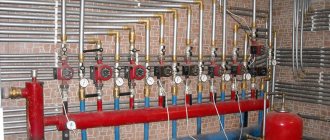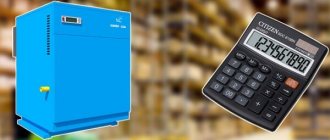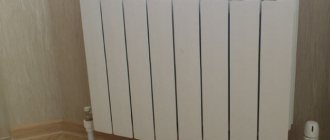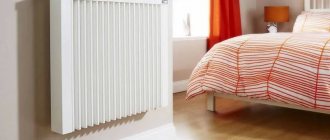What heats better, radiators or pipe registers?
In our house, under the windows, we have heating registers made of thick smooth pipes. I was wondering whether it is worth replacing them with radiators, which is better? What are their pros and cons?
Radiators (heating radiators) are made of various materials, cast iron, aluminum, steel, or several materials in one product, for example bimetallic radiators.
Their heat output is different, for example, an aluminum radiator warms up the room much faster than a cast iron one, but retains heat less well.
There is nothing special to compare with registers here; aluminum radiators heat better, cast iron radiators retain heat better and last longer than steel registers made even from a thick-walled pipe.
Registers are more of an industrial version of heating devices (warehouses, production facilities, hangars for various purposes, etc.),
These are their advantages, but in a private house, or even more so an apartment (for central heating I do not recommend using aluminum radiators, others are fine, aluminum is sensitive to the purity of the coolant), heating radiators are better, the aesthetic component comes first here.
The registers will have to be covered with screens (they look ambiguous in appearance), which will reduce their heat transfer.
Radiators heat better in any case, but much depends on the number of radiator sections and on the diameter of the pipes and the area of the registers.
And when using registers, a larger volume of coolant is needed (I mean water registers), and this costs fuel, more energy is spent on heating the coolant.
Source
Cast iron heating radiators
Let's look at the simplest and most common cast iron radiators. Their working pressure is 9 atmospheres, the maximum test pressure reaches 15 atmospheres.
The advantages of cast iron heating devices include excellent resistance to corrosion and undemanding requirements for cleanliness of the coolant. Due to this, cast iron radiators are widely used in city houses equipped with central heating. After all, corrosion resistance is a very important parameter. In the summer, water must be drained from heating systems, leaving the heating device to be torn apart by corrosion. A cast iron radiator will not rust while waiting for the new heating season.
The internal passage hole of the cast iron radiator has a large diameter. According to the laws of physics, this leads to low hydraulic flow resistance. In this regard, cast iron radiators are successfully used in heating systems with natural circulation.
But still the shortcomings are obvious. The main disadvantage: cast iron is too heavy a metal. Consequently, radiators have a large mass. This leads to a complication of the installation process of such a heating system with the need to use reliable fasteners.
Cast iron radiators are characterized by high thermal inertia. Therefore, they take a long time to heat up and take a long time to cool down. This temperature regime is not very comfortable: the air remains cold for a long time or, conversely, too warm.
It is unlikely that cast iron radiators decorate the interior. You always want to hide bulky heating systems from prying eyes. Cleaning will have to be done frequently and thoroughly, because the cast-iron structure in the form of sections tends to accumulate dust abundantly.
Cast iron heating radiators.
Pipes
At first glance, it may not seem important which heating pipes are used. But after considering the pros and cons of each material, it becomes clear why this is a serious issue. One of the most popular types of pipes is metal-plastic. Their diameter ranges from 16 to 63 mm.
metal-plastic pipes
Among the advantages of this material are:
- thermal conductivity is low,
- easy to repair,
- No professional tools needed for installation.
The disadvantages include the following:
- connections may leak,
- dents remain upon impact.
Another option that is often used is polypropylene.
polypropylene pipes and fittings
It has the following strengths:
- large diameter – up to 125 mm,
- resistance to mechanical pressure,
- when the system freezes, the pipes do not become unusable,
- There can be no fluid leakage after soldering.
However, there are also weaknesses:
- the need for expensive equipment to do the installation,
- elongate when the coolant is heated strongly,
- If damaged, they are difficult to repair.
When choosing pipes, it is better to take into account weather conditions, type of heating and financial capabilities.
Heating batteries
One of the main elements in the heating system. The efficiency of the entire heating system may depend on the incorrect selection of batteries. Nowadays there is a huge selection of radiators. If we classify them according to the material from which they are made, we can distinguish the following types: steel, cast iron, bimetallic and aluminum. In order not to sort out all the possible options, it is enough to understand the basic principles for choosing a battery.
- System type. The necessary criteria for a radiator depend on whether it is autonomous or central heating. For a centralized system, it is better to take batteries that can withstand pressure surges and water of varying acidity. For autonomous heating, you can use radiators of different pressures.
- Heat dissipation. According to this indicator, aluminum comes first, then steel, and then cast iron. But it’s also worth considering that, for example, cast iron takes longer to cool down.
- Life time. In this parameter, cast iron radiators come first, then bimetallic, steel and cast iron.
- Other criteria. This includes more visible parameters - design, price, manufacturer, and so on.
Taking into account all these factors, you can choose the best option for yourself.
Coolant
Without this component, the heating system will not work. The most common coolants are water and antifreeze.
- Water. Still, it is used more often. Since you don’t need to buy water for heating, this is a very economical option, and it transfers heat perfectly. In addition, water does not cause environmental harm.
- Antifreeze. There is one specially made for the heating system. Although you have to pay money for it, its main advantage is that it does not freeze at low temperatures.
When making a choice between water and antifreeze, it is good to weigh financial possibilities, heating system failures, weather conditions, and so on. The information listed above will help you choose the right elements of the heating system. Before choosing, it is important to carefully re-read all the advantages and disadvantages.
Comparative analysis of radiators
What is the first concern of the buyer of heating batteries? Three things:
- So that heating devices heat well and serve for a long time.
- Product price.
- Their appearance.
A comparison in appearance can be immediately ruled out, since the design of modern sectional radiators is almost the same, and the vast majority of products are coated with a durable white polymer coating. All that remains is to choose a heater at a height corresponding to its installation location.
Externally, bimetallic products are indistinguishable from aluminum
The first 2 points remain, by which it is worth judging which radiators are better - aluminum or bimetallic. In technical language, the comparison criteria sound like this:
- good heating is ensured by the heat transfer of the heating device;
- the duration of operation depends on the operating pressure and the ability to withstand the effects of low-quality coolant (corrosion resistance);
- The concept of price refers to 1 section of the device.
Reference. The need for bimetallic batteries arose due to high pressure in central heating systems of apartments and private houses, as well as due to the low quality of the coolant. Therefore, it is better to compare them with aluminum ones from this point of view.
Various types of side fins of sections
Comparing heat transfer
Aluminum and its alloys have excellent thermal conductivity of 220 W/m*K. For radiator silumin this figure is 150-180 W/m*K. In terms of heat transfer, only copper is better than them (λ = 380 W/m*K), but batteries are not made from it. In bimetallic radiators, a steel intermediary appears between the coolant and the aluminum body with much lower thermal conductivity - 70 W/m*K.
If we assume that the speed of water movement and its temperature are the same in devices made of silumin and bimetal, then the heat transfer of the latter will be less. Steel will not have time to take away as much heat from the coolant as silumin. This is in theory.
In practice, the heat transfer rates declared by manufacturers are almost the same for silumin and bimetallic sections. To verify this, just look at the table, which shows data for products from two well-known manufacturers - Global (Italy) and Rifar (Russia):
Note. The heat transfer values are indicated for certain conditions: the temperature difference between the coolant and the air in the room should be 70 °C (90 and 20 °C, respectively). This means that in reality the batteries will give off about 1.5 times less heat.
If we compare the sizes of the sections of the presented models, it will become noticeable that they are capable of transmitting approximately the same heat flow into the room. Hence the conclusion: both types of radiators heat equally efficiently and according to this criterion there is no difference between them.
Which batteries are more reliable?
The service life of heating devices operating in a central heating network depends on the corrosion resistance of the material and the pressure for which the radiator is designed. Regarding pressure, there are many horror stories floating around the Internet, their content boils down to one thing: aluminum sectional batteries cannot be installed in apartments with centralized heating, because they will be torn apart by water hammer and increased water pressure.
In fact, silumin products from all well-known manufacturers are designed for a working pressure of at least 16 Bar, and are tested at 24 Bar. This is despite the fact that the pressure in heating networks rarely reaches 14 Bar, taking into account tests and other operating conditions. As an example, the table shows the performance characteristics of products from several popular brands:
And to dispel the myth about bursting aluminum batteries, we suggest watching the video of our expert Vladimir Sukhorukov, where he conducts a tensile test of a steel radiator. Please note that steel appliances, unlike aluminum ones, are designed for a pressure of only 6 bar.
Sections of Global bimetallic models can withstand operating temperatures of up to 35 Bar, and are tested at 50 Bar. Characteristics from other brands are shown in the next table:
Such pressure indicators simply do not exist in any heating network, except for steam systems of industrial enterprises. Hence the logical question: why install a more expensive bimetal if aluminum is quite enough? Perhaps due to the corrosive effects of the coolant, which we will discuss later.
To make sure that your reasoning is correct, visit your heating supply company and ask to see data from pressure tests of the system (pressure testing is usually carried out at a pressure of 12 bar). And then compare them with the technical characteristics of heating devices of various types.
Sediment from the coolant in heating pipes and radiator channels.
Poor coolant in central heating systems is a problem in all countries of the post-Soviet space, resulting from the extreme deterioration of underground pipelines. Therefore, only cast iron batteries are “friendly” with such water; the rest face the following fate:
- Silumin remains resistant to corrosion if the pH value of the coolant does not leave the range of 7-8.5 units. A more acidic environment has a destructive effect on the alloy.
- Abrasive particles moving along with water through the channels of the heating device tirelessly bombard the surface of the aluminum alloy. True, a fistula from such exposure may appear many years later.
- The steel pipes of bimetallic radiators also corrode and become overgrown, although here too it will take quite a long time for the product to fail.
Leading manufacturers of silumin batteries practice applying a protective layer consisting of tri- or hexavalent chromium to the inner walls of the channels. Application method: electrochemical (passivation). Such measures practically equalize the chances of bimetallic and aluminum heating radiators in the fight against corrosion.
Which is cheaper?
According to general price statistics, bimetal costs on average 20-25% more than aluminum. At the same time, batteries with a steel frame have a limitation on the size of the flow area of the channels due to an additional element - a pipe. The remaining advantages and disadvantages of sectional alloy radiators are almost the same, as we had the opportunity to verify.
The difference in price is well reflected in the table with products of the same well-known brands:
Note: the cost of products from different companies is taken for the most popular size - 500 mm.
Basic heating options for a cottage 1. Main gas
This solution seems to be the simplest, but it can only be so if the site is initially gasified. Otherwise, the cost of laying the pipeline can range from 500 thousand to three million rubles per household: it all depends on the size of the village, the distance of the gas pipeline and other conditions.
Actually, gas is so far the cheapest type of fuel in Russia, but the ruble cost of its production is growing, and world prices are trending downward. Therefore, it is difficult to predict the situation for a long time. We proceed from the fact that an adequate calculation of the cost of heating involves an analysis of costs over a fairly long period of time, taking into account repair and operating costs. In particular, for a country house it is advisable to consider a 50-year operating period.
Let's assume that to heat a two-story cottage with an area of 300 m2 with a kitchen, you need an automatic boiler with a capacity of 15 kW.
Which boiler to choose?
When it comes to choosing, you should start from 4 main options. When considering each, you need to take into account what fuel is available and cheap in a certain area.
Gas
The gas boiler is the most popular due to the availability of this fuel. If we talk about its strengths, we can note the following:
- long service life,
- high efficiency, which means cost savings,
- ease of maintenance,
- there is no need to waste energy on fuel procurement when there is access to the highway.
Now about some weaknesses:
- permission to install the boiler is required,
- to connect you need to call special services,
- due to pressure surges in the gas pipeline, the unit turns off,
- Gas makes noise when it burns.
In general, it is an economical and reliable type of heating that requires only proper installation.
Electric boiler
This device is also quite popular. Here the heating of the coolant occurs due to electricity. Since it is widely available, it is worth considering this method from different angles. Advantages of electrical equipment:
- works without noise,
- relatively low cost,
- does not harm health or the environment,
- ease of operation.
The disadvantages include:
- when voltage surges occur, the device shuts down, and the automation is also disabled,
- electricity consumption,
- for a powerful unit you need a 3-phase network of 380 V.
Such a boiler is especially suitable when the price of electricity is inexpensive.
Solid fuel boilers
Quite a well-known type of boiler. Here, coal, firewood, and so on are used as fuel. Speaking about the advantages of such equipment, you should remember the following points:
- inexpensive type of fuel,
- ease of operation,
- does not require any documents for installation,
- easy to repair.
Here are some disadvantages:
- a lot of time and effort is spent on fuel procurement and boiler maintenance,
- There must be a chimney.
This heating method is quite often used in populated areas without a gas main.
Liquid fuel boilers
Liquid fuels such as fuel oil, kerosene and so on are used here. When listing the advantages of liquid fuel equipment, the following areas should be mentioned:
- heating independent of communications,
- ease of use,
- high efficiency,
Speaking about the disadvantages, it is necessary to remember the following nuances:
- a separate room for the boiler is required,
- expensive equipment,
- high cost of fuel,
- need for large fuel tanks.
Typically, liquid fuel heating units are not often used.
Basic heating options for a cottage 2. Gas holder
If there is no main gas, you can store liquefied gas. Many do this, although this method assumes that you will have a huge container of explosive liquefied gas constantly buried on your site. At a minimum, this requires a fairly large fenced area where nothing can be planted or built, and special security measures. In addition, an accessible source of liquefied gas is required with the possibility of delivery to the site.
The cost and efficiency of boilers for liquefied gas are approximately the same as for main gas. Installing a gas tank will cost about 400,000 rubles. In terms of 50 years, we get 800,000 rubles, or 16,000 rubles. in year.
If the cost of liquefied gas is 15 rubles per liter (with delivery within 100 km from a large city) and the specific heat of combustion of the propane-butane mixture is about 12.8 kW*h/l, we get the cost of 1 kW*h of heat at 1.23 rubles, which is equivalent to costs of 104,550 rubles. in year.
And taking into account the cost of operation - 120,550 rubles. in year.
Types of energy and coolants
Heat supply systems can be classified as follows:
- traditional, using liquid coolants that transfer heat from the heating unit through a pipeline to heating devices;
- air, using air as a coolant, which is heated and supplied to the heated room;
- direct electric, without coolant, but directly converting electricity into heat.
(See also: Heating a wooden house with a solid fuel boiler)
Traditional systems can use gas, liquid fuels - diesel fuel, fuel oil, electricity, solid fuel - as a coolant.
The most economical and optimal type of fuel is gas. The biggest disadvantage of these systems is the significant cost and complexity of documenting joining a centralized system.
The use of liquid fuel brings with it a lot of inconveniences: the difficulty of delivering and storing the energy carrier, and the need for increased safety measures. (See also: Heating boiler with a water circuit)
The disadvantage of traditional heat supply systems is the possibility of emergency coolant leaks, especially if antifreeze, a toxic and dangerous compound, is used. Periodic switching on of heating units and pumps creates noise and vibration. For trouble-free operation of the heating system, periodic maintenance of boilers is necessary.
For the operation of air heating systems, it is also necessary to install boiler equipment, which entails all of the above disadvantages. But from an environmental point of view, this system is more acceptable and promising. The heating system using air as a coolant is reliable and easily adjustable. However, even when using special filters, it does not protect the room from dust particles and other organic matter entering the air, which burn on the surface of the boiler equipment and form carbon monoxide.
Direct electric heating is inexpensive to install, but uses an extremely expensive source of thermal energy - electricity. (See also: Diagram and installation of metal-plastic heating wiring)
Aluminum radiators
Aluminum sectional radiators deserve attention. They quickly conquered the heating appliance market. Lightweight and easy to install, they have confidently replaced the heavyweights - cast iron radiators. Let's look at their obvious advantages.
Aluminum radiators have excellent heat dissipation. Therefore, in cold weather the room heats up very quickly. The low weight of the radiator facilitates their easy transportation and installation. And one more advantage: beautiful aluminum radiators fit perfectly into any modern interior.
The most popular models of aluminum radiators: 350mm and 500mm. The power and number of heating radiator sections depends on the area and height of the heated room.
Basically, two types of radiators are made: extruded and cast. Depending on the purpose of the room, aluminum radiators with a pressure parameter of 6 or 12 atmospheres are used.
Aluminum radiators, front and side views.
Basic heating options for a cottage 3. Diesel fuel
Diesel fuel is preferable to use in remote communities because it is usually easier to purchase and deliver to the site. In addition, you can transport it yourself. The efficiency of a diesel boiler is several percent lower, it costs a little more (a 15-kilowatt boiler costs about 40,000 rubles), and lasts a little longer - up to 15 years. An underground fuel tank with a supply system and installation will cost approximately 200,000 rubles. In addition, a diesel boiler is dependent on electricity: if the power goes out frequently, you will have to worry about purchasing a generator. We will consider the cost of service to be approximately the same everywhere - 5,000 rubles. in year. If we use these figures, then operating costs over 50 years at current prices will be 610,000 rubles. or 12,200 rub. in year. Let’s take the cost of diesel fuel for boiler houses, taking into account delivery, to be 36 rubles. per liter (varies depending on the region). The specific heat of its combustion is 10.3 kW*h/l. Those. the cost of 1 kWh of heat, taking into account the efficiency of diesel boilers, will be 3.93 rubles, and the cost of the heating season will be 333,800 rubles.
Taking into account operating costs - 346,000 rubles. in year.
What criteria to rely on when choosing heating radiators
Undoubtedly, the most important indicators are reliability, durability and safety. Of course, you are interested in the heating system working properly and for a long time for many years. It is unlikely that anyone will like the possibility of unexpected flooding of neighbors due to damage to radiators. This possibility should be minimal. The duration of trouble-free operation is a very important parameter that should be taken into account when purchasing a radiator.
By far the second most important criterion is the efficiency of the heating equipment. After all, radiators are installed so that, regardless of cold weather, the room always has the optimal air temperature. Radiators with better thermal conductivity will provide owners with the most comfortable living.
It is important to choose radiators with the ideal combination of “price and quality”. It's no secret: the modern standard of living forces many to save. Therefore, the cost of heating radiators is of considerable importance. By the way, each type of radiator has both disadvantages and advantages, because ideal equipment has not yet been invented.
In modern multi-storey buildings, water is used as a coolant. But passing through the pipes, such a coolant is a rather aggressive environment. Therefore, many radiators are subject to internal corrosion. Most modern heating radiators are coated on the inside with polymer protection. Please note: steel radiators are less susceptible to corrosion than aluminum ones. But the most reliable are the cast iron products we are used to, as well as some bimetallic radiators.
An important parameter for the effective operation of a radiator is operating pressure. Therefore, in the radiator you choose, this indicator cannot be less than the minimum value, which is 7 Atm. Radiators with a pressure rating of 15 atmospheres are the most optimal and are able to withstand water hammer.
All household radiators are qualified depending on the material used and design. The modern market offers consumers steel, cast iron and the most popular aluminum and bimetallic heating radiators. Let's try to figure out which of them to choose in this or that case.
Basic heating options for a cottage 4. Solid fuel
Firewood, pellets (briquettes) or coal can be used in this capacity. However, you need to understand that a solid fuel boiler is not fully automatic. This means that someone must always work as a fireman. In the case of pellet boilers, the level of automation is higher, but the level of danger of fuel fire is also higher.
This must also be taken into account when using coal boilers. Therefore, in both cases additional security measures will be required. The cost of equipment varies greatly. For example, a 15-kilowatt boiler with manual loading will cost about 25,000 rubles, but you are unlikely to enjoy the prospect of constantly running to the boiler room and adding firewood or coal by hand. A boiler with automatic fuel supply can cost from 100,000 (pellet) to 200,000 rubles. (carbonic). True, they all serve for 20–25 years.
As a result, operating a wood-burning boiler will cost 6,250 rubles. per year, automatic pellet - 10,000, and automatic coal - 15,000 (all taking into account the cost of annual maintenance).
The cost of fuel depends significantly on the region. For example, in the Moscow region, 1 cubic meter (on average 650 kg) of birch firewood at a wholesale price today will cost 1,400 rubles. (we believe that when ordering a large volume at once, delivery will be free), coal of acceptable quality - 6,000 rubles. per ton, fuel briquettes - at about the same price.
If we assume that the specific heat of combustion of wood is approximately 3.4 kWh/kg, coal - 7.5 kWh/kg and briquettes - 5.6 kWh/kg; that the efficiency of a wood-burning boiler is approximately 75%, and that of an automatic one is 80%; then we get the cost of 1 kWh of heat, respectively equal to 0.84, 0.64 and 0.85 rubles. (firewood, coal and briquettes). That is, heating with wood will cost 71,400 rubles per year, and heating with coal will cost 54,060 rubles. and briquettes - 72,420 rubles.
And taking into account operating costs: firewood - 77,650 rubles. in year; coal - 69,060 rub. in year; briquettes - 82,420 rub. in year.
Coal heating, as we see, is cheaper than heating with other types of solid fuel, but firewood has become more profitable than briquettes in 2021. But any solid fuel is more expensive than main gas.
Comparison of the efficiency of different heating systems
This article was written very long and hard. Not because we had to come up with something, but only because explaining in simple words understandable to most the advantages of, for example, water-heated floors over radiator heating in energy-saving terms turned out to be not such an easy task. Without introducing special physical terms and definitions, this is simply impossible. I had to somehow explain these aspects and explain them in a language more familiar to you and me.
So, many have probably already heard that heating with water heated floors is more effective than radiator heating . Heating with warm baseboards than radiators . But what lies behind this very efficiency, which is ultimately expressed in monthly utility bills, probably not everyone understands. Let's try to figure it out.
Heating using radiators , in principle, dates back to the distant 1875, when the first apartment with water heating appeared in Russia and throughout Europe. In those days, rather bulky pilasters acted as radiators. Before this, heating was predominantly stove. The problem was that the stove heating system was not suitable for large, multi-room premises, because... in the room in which the stove was located, comfortable conditions were created due to radiant heat transfer, while the rest were left to convective heat transfer. Due to the low efficiency of the latter, it was necessary to heat the furnaces much more, which increased the already considerable fuel consumption.
Due to the fact that the thermophysical properties of water, such as heat capacity and thermal conductivity, are several orders of magnitude superior to air in this regard, the radiator heating system has significantly increased the efficiency of heating buildings and reduced the consumption of firewood and coal.
Almost 140 years have passed since then. The design of radiators has been improved, as a result of which the heat removal per unit surface of these devices has increased, but these improvements have not eliminated the main and main drawback.
The fact is that, compared to the area of the room, the surface of the radiators is relatively small. This creates the need to heat the supplied coolant to high temperatures ( 70-90 oC ). And having such a high temperature, the radiator essentially ceases to be a radiator, i.e. The main method of heat transfer is no longer radiation, but convection.
The temperature field with this method looks like this: air heated from the radiator by natural
method, it rushes up to the ceiling, where initially having a temperature of about
+ 30 oC , the cooling air falls down, gradually losing its temperature. In the area of the feet, the air temperature is 17-20 oC . The floor temperature is 16-17 oC .
The figure clearly shows that air circulation is constantly maintained in the room, which, firstly, transports dust and suspended particles, and secondly, and importantly, a certain thermal work is spent on circulation. That is, radiators not only heat the air, but also give it movement energy. Nothing appears out of nowhere and an additional 4 to 7% of all thermal energy is spent on air circulation. The most important disadvantage of radiators, as you probably noticed from the diagram, is that outside the useful volume of the room the temperatures are relatively high (up to 30 ° C), which does not make any everyday sense (what difference does it make to you, how many degrees are 1 meter above your top . ), and at the same time, on the contrary, significantly increases heat loss through the ceiling and ventilation.
In short, heating with radiators requires heating the entire volume of the room in a certain way. The average temperature of the room in height is as follows: 1.5 meters above the floor level (60% of the room volume) - average temperature is about + 20 °C , floor level from 1.5 m to 2.5 m (40% of the room) - average temperature about +26 oC . Thus, the average actual temperature in a room of volume V will be determined by the equation:
Tsrrad. = (0.6×22 +0.4×26) = 24 oC .
Note that the higher the temperature in the room, the naturally higher its heat losses.
In order to begin to consider radiant heating systems, which include a warm water floor and a warm baseboard , it is necessary to introduce another important physical term - irradiance coefficient. Let us explain without resorting to intricate formulations from physics and trigonometry. The irradiance coefficient is the portion of thermal energy that can be radiated onto your body from any surface. Since humans are most often an upright creature, located at least 16 hours a day in a vertical plane, it is obvious that it is more difficult to radiate heat to our body from the surface of the floor than from the surface of the walls. This is how it works physically. Reference values of irradiation coefficients on the surface of the human body will be: from floor
0.130, from the wall
0.240. Next in order.
If, for example, the power of a heated floor in a room is 500 W 65 W will be directly radiated onto the human body (replenishing about 60% of all heat losses of the body), the rest of the heat is transferred through heat transfer through the feet (see the article “Water heated floor AVANTEN. Principles of reducing operating costs") and convection. The distribution of air temperatures throughout the room is quite even (see figure) and on average is about 20 oC . There is no air circulation; heat is transferred between air layers mainly by diffusion.
Heating with warm baseboards is essentially combined heating with warm walls and heated floors . Skirting boards do not work differently (see the article “The physical aspect of the efficiency of baseboard heating in buildings”). At the same time, thanks to the even greater radiant component in this type of heating (irradiance coefficient 0.240 ), a person feels quite comfortable in the room even if the air temperature in it is set at +18 ° C, thanks to its fairly uniform distribution throughout the volume. The average temperature, with a slight approximation, can be taken to be about 19 °C. Heating with a warm baseboard does not directly heat the surface of the floor and walls, but mainly due to the convection of a small volume of air flowing along their surfaces. In this case, at best, about 1% of thermal energy is spent on thermal work.
Thus, based on the ratio of average temperatures in the rooms, it will be easy to calculate in numbers the comparative efficiency of a particular heating system.
The physical meaning of the numbers given in the table boils down to the fact that
if the same room is heated so that the person in it is comfortable, alternately with three different systems, then the greatest heat loss will be in the room with radiators, a room with a water-heated floor will require 21% less energy, while a room with a warm baseboard will reduce the need for heat by 24% .
And, all this is thanks mainly to a more rational distribution of heat throughout the volume of the building. We consider it necessary to note that, as can be seen from the article, the calculation example is shown for a building with a standard (apartment) ceiling height . As the height of the room increases, the difference in energy efficiency between radiators and radiant heating systems (water-heated floors and heated baseboards) will only increase .
Pros and cons of aluminum batteries
Radiators made of aluminum differ from products made of other metals:
- high heat transfer coefficient;
- light weight and small size (which greatly simplifies their delivery and installation);
- ability to withstand high temperatures of the heat-carrying fluid;
- optimal ratio of cost and thermal power;
- durable external powder coating;
- quick response to changes in coolant temperature;
- the ability to create a long-lasting designer coating;
- convection heating method, which prevents dust from settling in the spaces between sections.
Despite such a huge number of advantages, there are also disadvantages:
- Increased requirements for coolant quality . When using low-quality or improperly prepared coolant in radiators, electrochemical corrosion begins, which can not only spoil the appearance of the product, but also render it unusable. To avoid corrosion if it is impossible to control the quality of the heating fluid, a special polymer coating is applied to the inner surface. But this leads to an increase in the price of the product.
- Fear of water hammer . When preparing for the heating season, pressure testing of the heating system is often carried out, during which coolant can be supplied into it under high pressure. Such impacts are very dangerous for extruded batteries: they can cause individual sections to become detached.
- Susceptibility to corrosion of connecting elements . If these elements are made of copper or steel, and the battery is made of aluminum, then excellent conditions are created for electrochemical corrosion. To prevent such an unpleasant phenomenon, instead of copper and steel connecting elements, it is recommended to use similar products that are nickel-plated, chrome-plated or coated with cadmium.










